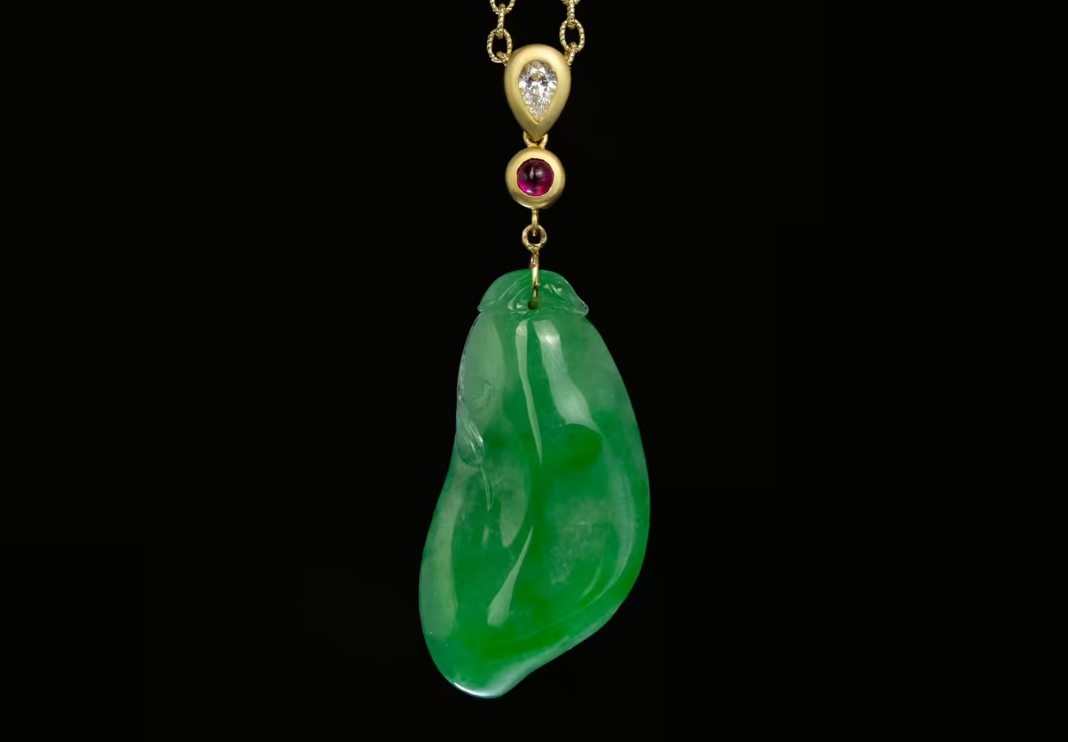In a move that aligns with evolving international gemological standards, Mason-Kay Jade has begun including the term “Fei Cui” in its jadeite testing reports. Joining a growing number of industry institutions such as GIA and Lotus Gemology, the Colorado-based jade specialist aims to promote clearer, more accurate communication about one of the world’s most culturally and mineralogically complex gemstones.
A unifying term for a complex material
As of June 1, Mason-Kay Jade has officially incorporated the Chinese term “Fei Cui” into all of its Jadeite Authenticity Reports. Each document now carries the following explanation: “Internationally known as ‘Fei Cui,’ an umbrella term for pyroxene jades comprised primarily of jadeite, omphacite, kosmochlor, or any combination thereof.”
Fei Cui (pronounced fay choy) is the Mandarin term commonly used across Asia to refer to what the West traditionally calls “jadeite jade.” However, jadeite jade is not a single mineral, but rather a polycrystalline rock made up of a mixture of jadeite, omphacite, and kosmochlor—each of which belongs to the pyroxene mineral group. These components often intermix on a microscopic level, making it extremely difficult, if not impossible, to determine a specimen’s precise mineral composition.
This mineralogical complexity has led to growing recognition within the gemological community that jadeite should be understood as part of a broader category, one that reflects its blended nature. By adopting Fei Cui terminology, Mason-Kay joins this shift in perspective and aims to improve clarity in jade testing and communication.
Responding to evolving gemological standards
Mason-Kay Jade’s decision follows similar moves by some of the industry’s leading gemological laboratories. In 2012, the Gemological Institute of America (GIA) published a landmark paper titled “The Jadeite-Omphacite Nomenclature Question”, which examined the ambiguity in differentiating between jadeite and omphacite. More than a decade later, in 2023, GIA updated its jade reports to incorporate the Fei Cui term, accompanied by explanatory notes when relevant.

Meanwhile, Lotus Gemology—one of the world’s leading authorities on colored gemstones—further advanced the conversation with the release of its 2024 book detailing the evolution of jade terminology. The book explains how the intermixing of jadeite with omphacite and kosmochlor often renders mineralogical distinctions meaningless for practical testing purposes.
Organizations in Asia have also taken steps toward harmonizing terminology. Hong Kong’s Jade and Stone Laboratory, and the Fei Cui Working Group under the CIBJO (World Jewellery Confederation) umbrella, are working to create international standards that reflect both scientific accuracy and cultural authenticity. The term Fei Cui, long used in Chinese markets and literature, is increasingly viewed as the most appropriate descriptor for these pyroxene-rich jades.
Clarity, consistency, and cultural respect
Mason-Kay Jade, which has specialized in natural jadeite for over 40 years, emphasized that the adoption of Fei Cui is part of its ongoing commitment to accuracy and transparency. The term now applies to all pyroxene jades tested by the lab, including jadeite jade, jadeite-omphacite jade, omphacite jade, and kosmochlor jade.
“By including this terminology in our Jadeite Authenticity Reports, we stand with the global gemological community in advocating for clarity, consistency, and respect for the mineralogical diversity within the jadeite family,” said a spokesperson for the company. Crucially, Mason-Kay noted that this shift also aims to prevent the misrepresentation or devaluation of jade materials, particularly omphacite-rich jades, which are often considered inferior by consumers unaware of their true nature or value. In an industry where the line between “desirable” and “undesirable” can be shaped more by terminology than science, the need for uniform language is increasingly urgent.
A step toward standardization
For decades, jadeite has occupied a unique position in both the gem trade and cultural traditions—especially in East Asia, where jade carries deep symbolic meaning. Yet the lack of standardized terminology has long led to confusion among consumers and even professionals. A single stone might be labeled “jadeite” by one lab, “Fei Cui” by another, and “omphacite jade” by a third, despite all referring to similar materials.
This confusion has real-world consequences, from pricing discrepancies to customer distrust. That’s why organizations like the Fei Cui Working Group are developing globally recognized definitions and grading systems. Mason-Kay’s decision to include Fei Cui on its reports is both a nod to these efforts and a call to action for others in the industry to follow suit. By bridging the gap between scientific mineralogy and cultural usage, Fei Cui serves as a unifying term—one that honors jade’s multifaceted nature while promoting clarity in commerce.
Looking ahead
The inclusion of Fei Cui terminology marks a meaningful evolution in how jade is communicated in the gemological world. It also reflects a broader trend toward cultural inclusivity in the language of gemstones, recognizing the terms and traditions long used by the communities most closely tied to these stones.
For Mason-Kay Jade and others in the gemological community, this is more than a linguistic update—it’s a step toward global alignment in an industry rooted in both science and story. And for collectors, retailers, and gem lovers worldwide, that clarity is something worth treasuring.



